5" gauge Stanier Duchess steam loco
Discussion
Here are some more photos - nice Britannia btw. I'm going to have this on display in a similar manner after it's run a few times - along with my 3 1/2" Duchess Of Hamilton. I've currently got this Duchess in the spare room so light isn't great and it's on the floor so views are restricted. It's too heavy to lift on my own so that's where it's staying for the time being.
Incidentally - the fire doors were one of the last things my Dad made - we took a trip to York museum to get photos of the doors on Duchess Of Hamilton; he was interested in looking at the flip up plate that was used when running - apparently they used to drive them with the fire doors open and this plate up between shovelfuls of coal. We got photos - he then scaled drawings and built 'em.
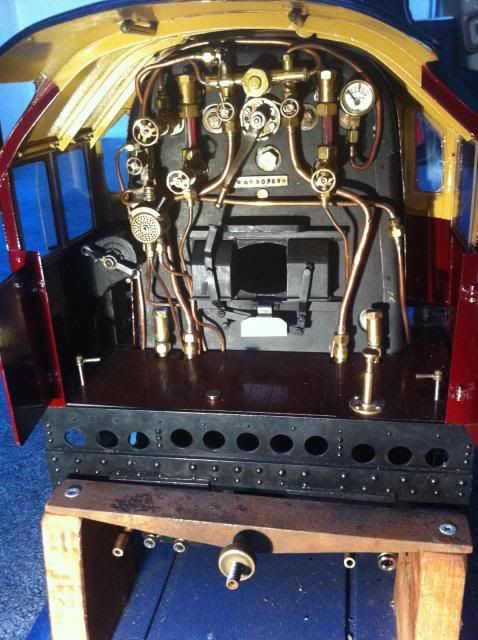 [/URL]
[/URL]
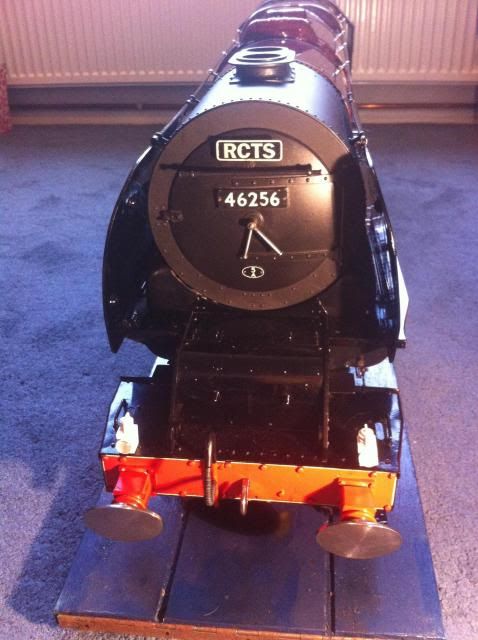 [/URL]
[/URL]
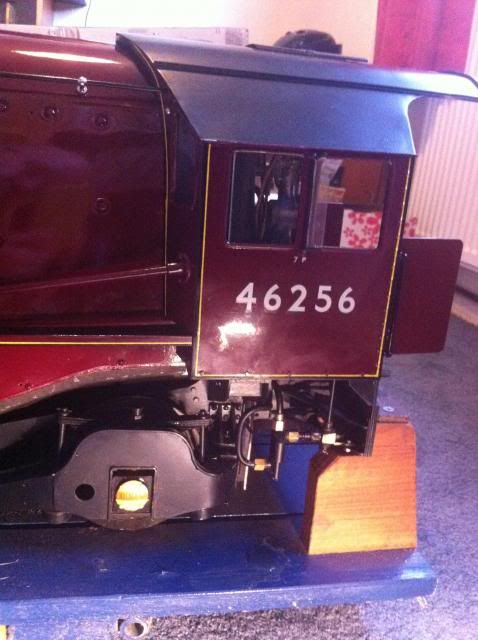 [/URL]
[/URL]
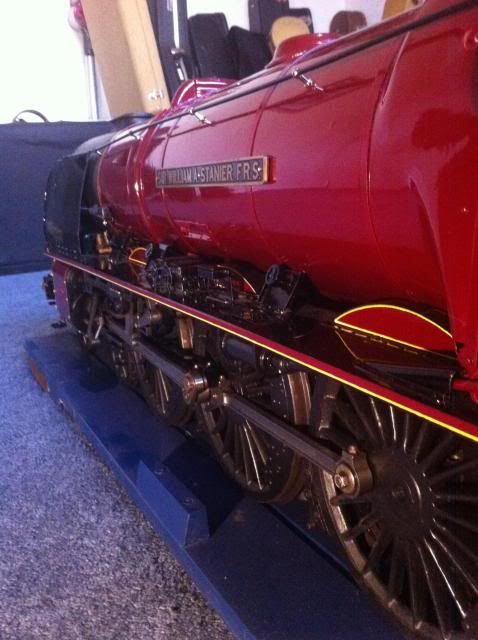 [/URL]
[/URL]
Incidentally - the fire doors were one of the last things my Dad made - we took a trip to York museum to get photos of the doors on Duchess Of Hamilton; he was interested in looking at the flip up plate that was used when running - apparently they used to drive them with the fire doors open and this plate up between shovelfuls of coal. We got photos - he then scaled drawings and built 'em.
 [/URL]
[/URL] [/URL]
[/URL] [/URL]
[/URL] [/URL]
[/URL]Edited by Dawg on Thursday 21st November 18:53
The tender was completed by my Dad back in the mid '80's - it just needed painting.
He made his own drawings for a working coal pusher scaled from works drawings - as featured on the actual tenders..
 [/URL]
[/URL]
There's also a functioning water scoop - handle on the right..
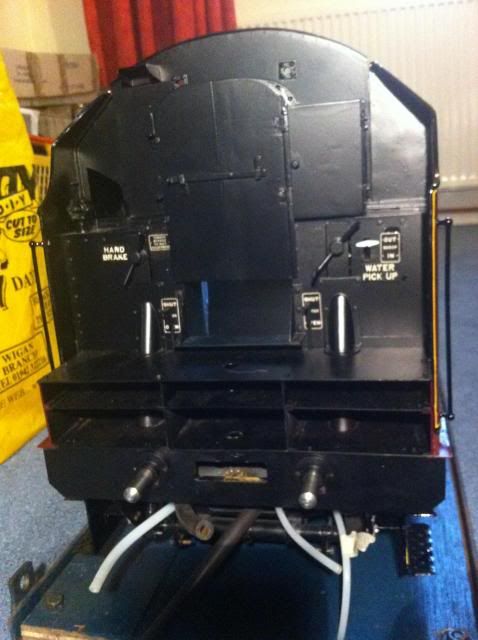 [/URL]
[/URL]
My one niggle - tender BR emblem is a bit smaller than it should be. I can live with it though...
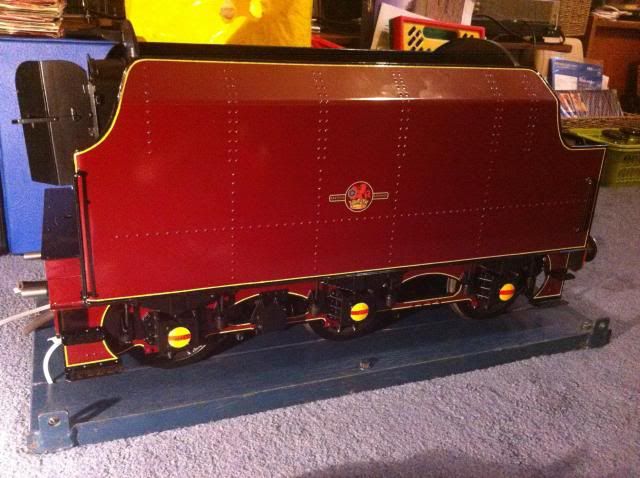 [/URL]
[/URL]
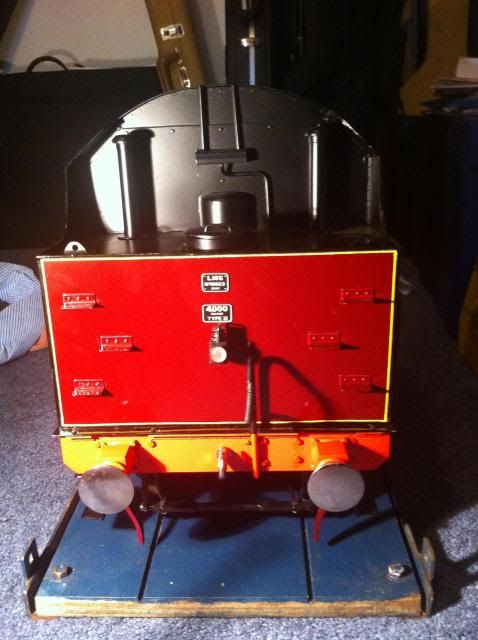 [/URL]
[/URL]
He made his own drawings for a working coal pusher scaled from works drawings - as featured on the actual tenders..
 [/URL]
[/URL]There's also a functioning water scoop - handle on the right..
 [/URL]
[/URL]My one niggle - tender BR emblem is a bit smaller than it should be. I can live with it though...
 [/URL]
[/URL] [/URL]
[/URL]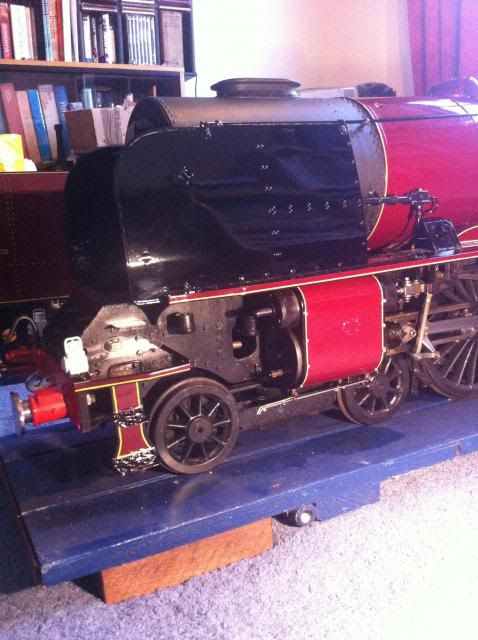 [/URL]
[/URL]Front L.H Cylinder detail
Razor11 - seeing your Britannia reminded me of a story told to me by a friend of my father called Norman Lowe - he was an incredible model engineer and a fountain of knowledge, now sadly departed.
Norman was chief pattern maker at Horwich loco works, up here in Lancashire. In the mid '60's he was walking through the repair shop and there stood a Britannia (I think it was Morning Star). Now, at Horwich, usual suspects were grubby Black 5's, 8F's Stanier 2-6-4 Tanks etc... So something the size of a Britannia was unusual.
"Why was it in"? Norman had asked - turned out that a near disaster had occurred on the Settle Carlisle line. The loco had been thundering along on a Leeds-Carlisle express somewhere near Hellifield and, as it was the mid '60's, maintenance was no longer a prime objective on BR steam locos.
The Britannia's 8ft long connecting rod that linked the centre driving wheel to the cylinder had come adrift. It fixes to a slide bar via a linkage called a crosshead which in turn is connected to the piston inside the cylinder. The slide bar had fallen off, dropping the connecting rod onto the ground, whilst still connected to the centre driving wheel. Whilst in motion, this rod ploughed repeatedly into the track & sleepers, tearing them up as it went along. The carriages, with passengers on board all derailed. Thankfully and amazingly, no one was hurt...
So Razor11 - if you run it, check your slide bar's attached to the cylinder securely

Edited by Dawg on Friday 22 November 10:17
Not a stupid question at all.
You have to fully build the loco in a bare metal state (check the Britannia out on the previous page) the boiler on completion also has to have a hydraulic pressure test
Then it has to be dismantled in big lumps - boiler off & painted, separate from cab, running boards which are also painted lined separately etc...
Most folks paint the frames and wheels before all the running gear goes on - that's what happened with mine. My Dad painted them about 10 years ago.
Then reassemble, steam test and away you go..
You have to fully build the loco in a bare metal state (check the Britannia out on the previous page) the boiler on completion also has to have a hydraulic pressure test
Then it has to be dismantled in big lumps - boiler off & painted, separate from cab, running boards which are also painted lined separately etc...
Most folks paint the frames and wheels before all the running gear goes on - that's what happened with mine. My Dad painted them about 10 years ago.
Then reassemble, steam test and away you go..
Dawg said:
 [/URL]
[/URL]Front L.H Cylinder detail
Razor11 - seeing your Britannia reminded me of a story told to me by a friend of my father called Norman Lowe - he was an incredible model engineer and a fountain of knowledge, now sadly departed.
Norman was chief pattern maker at Horwich loco works, up here in Lancashire. In the mid '60's he was walking through the repair shop and there stood a Britannia (I think it was Morning Star). Now, at Horwich, usual suspects were grubby Black 5's, 8F's Stanier 2-6-4 Tanks etc... So something the size of a Britannia was unusual.
"Why was it in"? Norman had asked - turned out that a near disaster had occurred on the Settle Carlisle line. The loco had been thundering along on a Leeds-Carlisle express somewhere near Hellifield and, as it was the mid '60's, maintenance was no longer a prime objective on BR steam locos.
The Britannia's 8ft long connecting rod that linked the centre driving wheel to the cylinder had come adrift. It fixes to a slide bar via a linkage called a crosshead which in turn is connected to the piston inside the cylinder. The slide bar had fallen off, dropping the connecting rod onto the ground, whilst still connected to the centre driving wheel. Whilst in motion, this rod ploughed repeatedly into the track & sleepers, tearing them up as it went along. The carriages, with passengers on board all derailed. Thankfully and amazingly, no one was hurt...
So Razor11 - if you run it, check your slide bar's attached to the cylinder securely

Edited by Dawg on Friday 22 November 10:17
Dawg said:
Razor11 - seeing your Britannia reminded me of a story told to me by a friend of my father called Norman Lowe - he was an incredible model engineer and a fountain of knowledge, now sadly departed.
Norman was chief pattern maker at Horwich loco works, up here in Lancashire. In the mid '60's he was walking through the repair shop and there stood a Britannia (I think it was Morning Star). Now, at Horwich, usual suspects were grubby Black 5's, 8F's Stanier 2-6-4 Tanks etc... So something the size of a Britannia was unusual.
"Why was it in"? Norman had asked - turned out that a near disaster had occurred on the Settle Carlisle line. The loco had been thundering along on a Leeds-Carlisle express somewhere near Hellifield and, as it was the mid '60's, maintenance was no longer a prime objective on BR steam locos.
The Britannia's 8ft long connecting rod that linked the centre driving wheel to the cylinder had come adrift. It fixes to a slide bar via a linkage called a crosshead which in turn is connected to the piston inside the cylinder. The slide bar had fallen off, dropping the connecting rod onto the ground, whilst still connected to the centre driving wheel. Whilst in motion, this rod ploughed repeatedly into the track & sleepers, tearing them up as it went along. The carriages, with passengers on board all derailed. Thankfully and amazingly, no one was hurt...
So Razor11 - if you run it, check your slide bar's attached to the cylinder securely
http://www.railwaysarchive.co.uk/documents/MoT_Set...Norman was chief pattern maker at Horwich loco works, up here in Lancashire. In the mid '60's he was walking through the repair shop and there stood a Britannia (I think it was Morning Star). Now, at Horwich, usual suspects were grubby Black 5's, 8F's Stanier 2-6-4 Tanks etc... So something the size of a Britannia was unusual.
"Why was it in"? Norman had asked - turned out that a near disaster had occurred on the Settle Carlisle line. The loco had been thundering along on a Leeds-Carlisle express somewhere near Hellifield and, as it was the mid '60's, maintenance was no longer a prime objective on BR steam locos.
The Britannia's 8ft long connecting rod that linked the centre driving wheel to the cylinder had come adrift. It fixes to a slide bar via a linkage called a crosshead which in turn is connected to the piston inside the cylinder. The slide bar had fallen off, dropping the connecting rod onto the ground, whilst still connected to the centre driving wheel. Whilst in motion, this rod ploughed repeatedly into the track & sleepers, tearing them up as it went along. The carriages, with passengers on board all derailed. Thankfully and amazingly, no one was hurt...
So Razor11 - if you run it, check your slide bar's attached to the cylinder securely

Edited by Dawg on Friday 22 November 10:17
Wow! You beauty for finding that. Norman told me that story about 10 years ago so specifics after 40 years get a little mixed up. Norman definitely said it was at Horwich loco works though - at that time it would have been the closest serious engine works to Settle and I guess it must have been en-route to Crewe where the full examination was done.. I now remember him saying that there was a freight loco involved - that's where the mention of Leeds - Carlisle must have come from..
I'll be having a good read of that later - thanks chap
I'll be having a good read of that later - thanks chap

Edited by Dawg on Friday 22 November 20:30
RichB
Different folks do it different ways - my Dad used to spray them and then line. Others think that a brush finish is superior, as long as you have *everything* in place regarding best paint, best brushes, best technique... - this was brush painted by Lynx Modelworks, though the smokebox, cab roof are a matt finish suggesting they were sprayed. The guy who does it - that's his job allocation. I'm particularly impressed by his lining skills...
There's a great book I bought when I was gearing myself up to finish this engine, (and before reality kicked in)
http://www.amazon.co.uk/How-Paint-Locomotive-Chris...
I bought one of these for lining too - my 3 1/2" gauge 46229 Duchess of Hamilton is in a sorry looking state, so i'm going to have a go at repainting next year, so it'll come in use
http://www.beugler.com/
Different folks do it different ways - my Dad used to spray them and then line. Others think that a brush finish is superior, as long as you have *everything* in place regarding best paint, best brushes, best technique... - this was brush painted by Lynx Modelworks, though the smokebox, cab roof are a matt finish suggesting they were sprayed. The guy who does it - that's his job allocation. I'm particularly impressed by his lining skills...
There's a great book I bought when I was gearing myself up to finish this engine, (and before reality kicked in)
http://www.amazon.co.uk/How-Paint-Locomotive-Chris...
I bought one of these for lining too - my 3 1/2" gauge 46229 Duchess of Hamilton is in a sorry looking state, so i'm going to have a go at repainting next year, so it'll come in use
http://www.beugler.com/
Edited by Dawg on Friday 22 November 21:49
What a tremendous thing, and such a stunning item to be able to proudly keep as a legacy of your dad 
It baffles me how much work must go into something like that. Every time I look at the pictures I see something else that must have taken an hour or two to make and you barely notice on first glance!

It baffles me how much work must go into something like that. Every time I look at the pictures I see something else that must have taken an hour or two to make and you barely notice on first glance!
Indeed Simon - He'd spend hours sat in his armchair with a drawing pad and photos scaling and making drawings and then disappearing making making bits only then to discard them for a 'better' version. Problem was that he never threw away mk1,2 or 3 - so when it came to be finished, I had a bench full of bits with no idea which version was the final working piece, each one with hours of work put into it.
'Twas difficult to sort - I had to get his best friend who is also a fine model engineer to come down and look over everything bit by bit..
We got there in the end
'Twas difficult to sort - I had to get his best friend who is also a fine model engineer to come down and look over everything bit by bit..
We got there in the end

Gassing Station | Scale Models | Top of Page | What's New | My Stuff




 [/URL]
[/URL]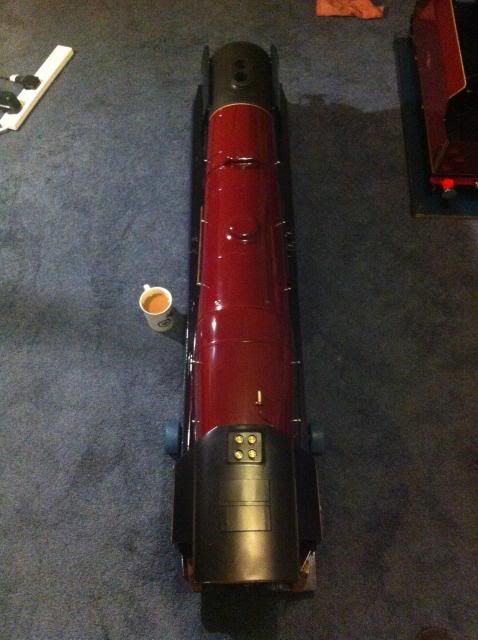 [/URL]
[/URL]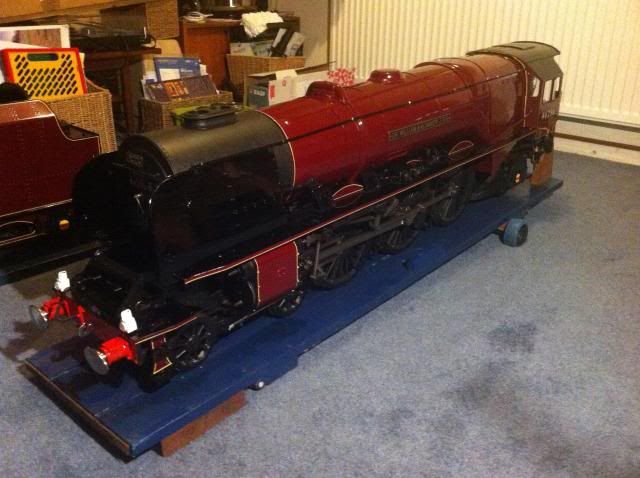 [/URL]
[/URL]